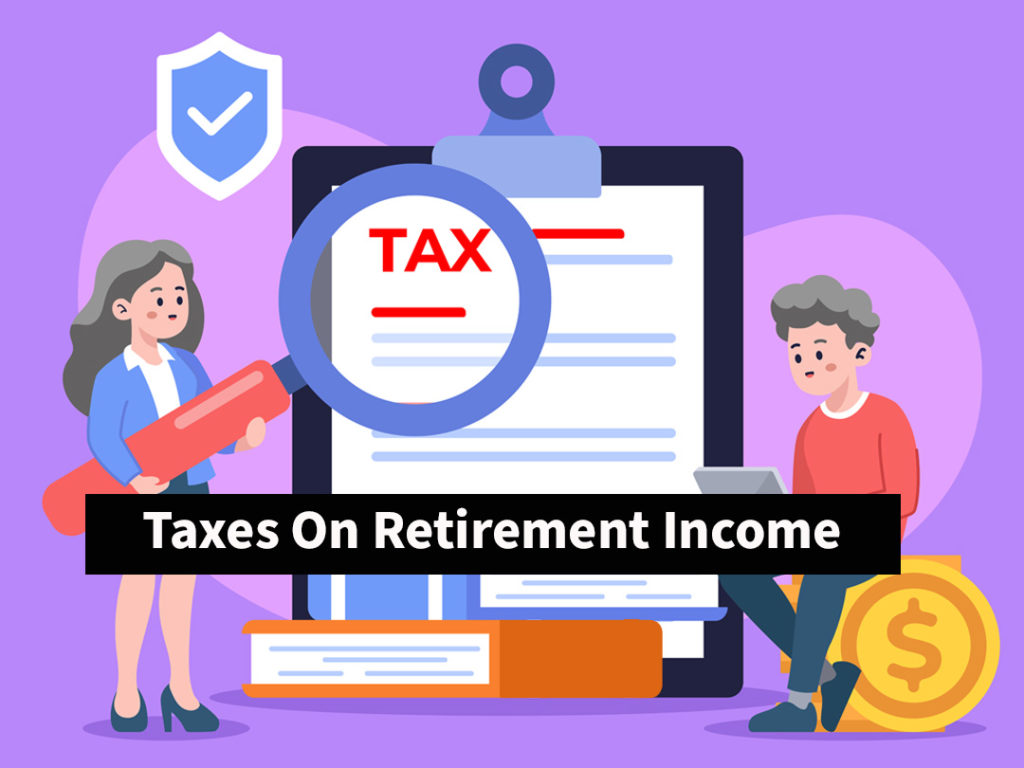Taxes on retirement income depend on a number of variables. These include the amount of total income received in retirement, the types of income source, and where you live (Stats tax retirement income differently).

Tax On Social Security Benefits
Taxes on Social Security income is based on your overall income, and how you file your taxes. Married couples filing separately receive no tax breaks. However, for everyone else, there is a “Base Amount” that varies for the type of filer. The Base Amount is deducted from social security income and other qualifying income. This determines the amount of your income subject to tax. You add up all your qualifying income and deduct the Base Amount. If this number is positive, that’s what you owe taxes on. The IRS worksheet is available here.
Retirement Taxes on Pensions
Seniors are subject to income taxes on their pensions and withdrawals from all tax-deferred investments for the year taken. Tax-deferred investments include annuities, traditional IRAs, 401(k)s, 403(b)s, and similar retirement plans. As seniors receive money from pensions, periodic pensions, and annuities they will owe federal income tax at their regular rate. Lump-sum distributions from pension programs subject the recipient to tax on the lump sum unless transferred to an IRA. In which case, no taxes are owed until withdrawn. Always seek the advice of a tax expert before making choices on retirement funds.
State Retirement Taxes On Pensions
States elect to tax pension income. Some have relatively high tax rates n pensions, some have no taxes. Knowing a state’s tax rates on pensions can influence where a senior decides to spend their retirement years. A few extra thousand dollars a year can make a big difference in your retirement years. A state can only tax pensions of their legal residents. That means if you worked and earned a pension in California, a state that taxes pensions, and then move to a state that does not (like Florida), California has no recourse to the pension earned in their state.
Taxes on 401(k)s And IRAs
IRAs and 401(k)s are deferred retirement saving vehicles. The government allows you to put money into these accounts prior to retirement tax-free. Then when you reach retirement age or start to withdrawal these savings, the taxes begin. In most cases, the senior is in a lower tax bracket than when they were younger. Even if the senior’s tax bracket is higher, the savings compounded tax-free prior to retirement and withdrawals.
Taxes On Individual IRAs
Once you start taking funds out of a traditional IRA you owe tax on the earnings portion of those withdrawals at your regular income tax rate. Keep in mind that if you were allowed and chose to deduct any portion of your contributions, you’ll owe tax at the same rate on the full amount of each withdrawal. This gets complicated. The IRS explains the rules in publication Publication 590, Contributions to Individual Retirement Arrangements (IRAs).
Retirement Taxes On Individual Roth IRAs
Roth IRAs are highly tax-favored on withdrawals. You open a Roth with after-tax money. Unlike other forms of retirement accounts, Roth contributions do not shelter your taxable income. The benefit is on the withdrawal side. You pay no taxes on earnings as they accumulate, and no taxes when you make withdrawals. However, this tax treatment accrues only after the account has been held for a period of time. Currently, the hold period for favored tax treatment is five years.
Taxes On Traditional 401(k), 403(b) And 457 Salary Reduction Plans
Retirement taxes on income produced from traditional 401(k), 403(b) or 457 salary reduction plans came from combinations of your employer contributions, your contributions, and earnings on the contributions. You’ll owe income tax on these amounts when you receive them. The tax will be at your regular ordinary rate.
Mananging Investments In Retirement – How Ordinary Rates And Capital Gains Rates Effect Taxes
Once a retirement portfolio gets to a large size, there are many ways to manage taxes in retirement Specifically, a professional manager will look at ways of managing gains and losses among accounts, and over time. Always consult with an investment specialist when it comes to managing large investment accounts.
One of the biggest issues is making decisions about short and going term gains. From a policy perspective, the federal government believes that holding investments for the long-term is more advantageous than holding them for the short-term. To encourage this behavior, there is a lower tax on long-term holdings. This is called long-term capital gains.
Interest paid on investments in taxable accounts is taxed at your regular rate. But other income—from both your capital gains and qualifying dividends—is taxed at the long-term capital gains rate of between 20 percent and 0 percent, depending on your tax bracket. This is true when you have owned the investment for more than one year. This lower tax rate on most of your earnings is one of the major advantages of taxable accounts, though it’s not the only one. There are no required withdrawals from taxable accounts and no tax penalty for taking income from these accounts before you turn 59½. This means you have greater flexibility in deciding which investments to tap for income and which to preserve for later needs.